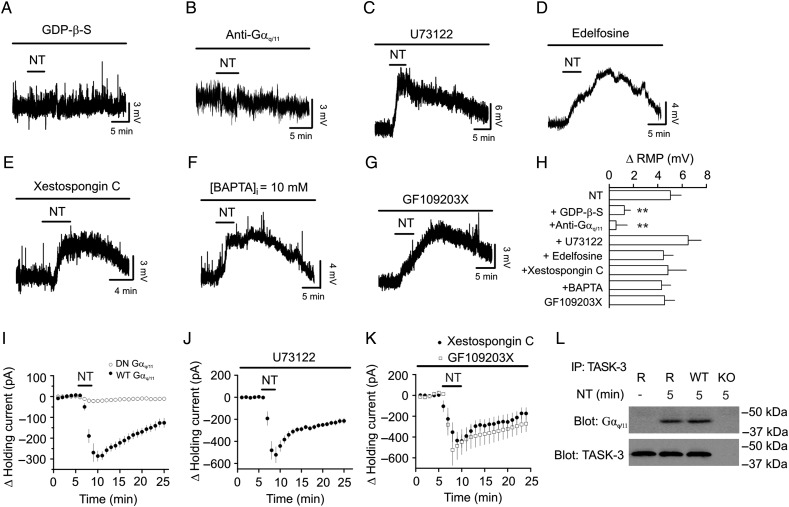Figure 6.
NT-mediated depolarization is mediated by direct coupling of Gαq/11 to TASK-3 channels. (A) Inclusion of GDP-β-S in the recording pipettes blocked NT-induced depolarization. (B) Inclusion of anti-Gαq/11 in the recording pipettes blocked NT-mediated depolarization. (C) Application of U73122, a PLC inhibitor, did not change NT-induced depolarization. (D) Application of edelfosine, another PLC inhibitor, did not block NT-induced depolarization. (E) Intracellular application of xestospongin C, a IP3 receptor blocker, failed to block NT-induced depolarization. (F) Intracellular application of BAPTA did not change NT-mediated depolarization. (G) Application of GF109203X, a PKC inhibitor, did not alter NT-induced depolarization. (H) Summary bar graph. **P < 0.01 vs. NT alone. (I) NT induced a significantly smaller inward HC in HEK293 cells co-transfected with NTS1, TASK-3, and DN-Gαq/11 compared with those cells co-transfected with NTS1, TASK-3, and WT-Gαq/11. (J) Application of U73122 did not change NT-induced increases in inward HCs in HEK293 cells coexpressing NTS1 and TASK-3. (K) Inclusion of xestospongin C in the recording pipettes or bath application of GF109203X did not alter NT-mediated increases in inward HCs in HEK293 cells transfected with NTS1 and TASK-3. (L) Association of Gαq/11 with TASK-3 channels was detected in the lysate of the rat dentate gyrus immunoprecipitated with antibody to TASK-3 channels after the activation of NTS1. Rat dentate gyrus (denoted as R in the figure) was treated with or without NT for 5 min before being lysated. As a control, application of the same experimental procedures detected the association of Gαq/11 with TASK-3 channels in the samples prepared from WT mice but not in those prepared from TASK-3 KO mice.

